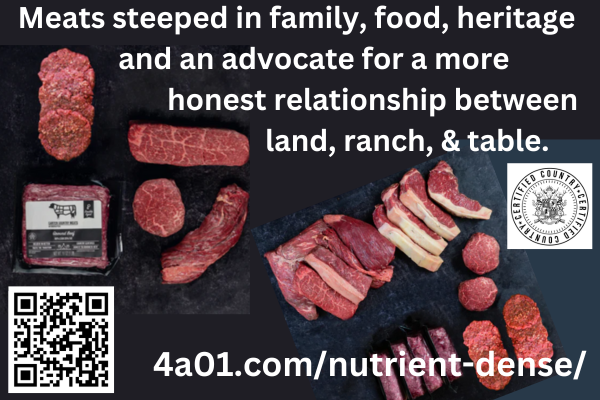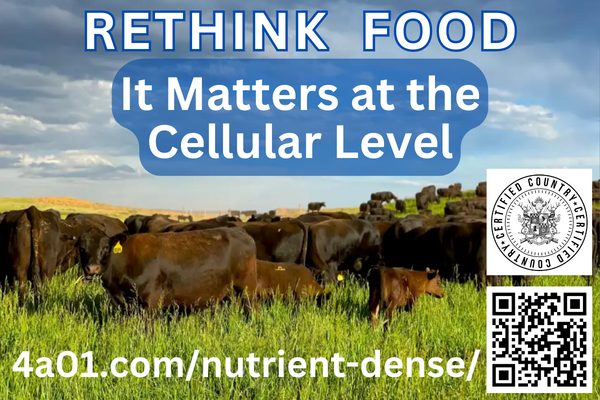Nutrient dense foods produce a healthy body and mind. Keen awareness of our environment should make us choose our food source wisely. In recent years, the way we think about food has evolved. There’s a growing awareness of the environmental impact of our dietary choices and a greater focus on consuming nutrient dense foods. One remarkable option addressing these concerns is raising beef on open ranges, fed only a grass-based diet. This article will explore how open-range, grass-fed beef is not only better for the environment but also produces a nutrient dense food source that surpasses what is typically found in grocery stores.
Sustainable Ranching Practices Produce Nutrient Dense Food:
Open-range ranching practices are a stark contrast to conventional feedlots that confine cattle to crowded spaces, consuming grain-based diets. These open-range systems allow cattle to graze on natural pastures which promotes healthier ecosystems. These practices result in lower greenhouse gas emissions, reduced water usage, and decreased soil degradation compared to intensive feedlot operations. This knowledge should make your choice of beef clear. Listed below are just a few of the considerations when choosing open-range grass-fed beef for your family.
Reduced Greenhouse Gas Emissions: Grass-fed cattle produce fewer methane emissions than grain-fed counterparts, contributing less to climate change. This reduces their carbon footprint, making grass-fed beef a greener option.
Water Conservation: Grass-fed cattle systems generally require less water than the production of grain-based feeds, further mitigating environmental stress.
Grass-Fed Beef Versus Grass-Finished Beef
I think we need a side note here about what is grass-fed versus grass-finished. The term “Grass-fed beef” describes meat from cattle that ate grass at the beginning of their lifecycle. “Grass-finished beef” comes from cattle that ate nothing but grass and forage for their entire lives. Did you get that? When you consider it there is a very big difference.
“Grass-fed beef” on the other hand, may be used to label meat from cattle that were started on a grass diet but have either received supplemental grain feed or are finished on a fully grain-based diet. The truth is the majority of “grass-fed beef” labeled in grocery stores, although labeled “grass-fed”, spent the last several months of their lives eating grain in feedlots to help them quickly gain weight.
Commercial agriculture is being compensated by the weight of the beef sold, therefore fattening them up is crucial for their bottom line, not our health. According to the USDA, it is not a requirement for cattle to have a full grass-fed diet in order to get the “grass-fed” label on your beef’s packaging. Is this surprising to you? One more point to bring out, “grass-fed” is not necessarily pasture-raised. What that means, among other things, is that the cattle are not free-range consuming a variety of diversified grasses.
Corporate agriculture in the United States currently allows commercial feedlots to confine cattle to pens that house between 100 – 125 animals and allow 125 – 250 square feet per animal!
Research Results: Best Nutrient Dense Beef Delivered to YOUR Door
We have found the highest quality nutrient dense beef and it is now available for delivery!!! This Ranch is nestled in the western slope of the Big Horn Mountains. 40,000 wild acres, fed by twenty-seven natural springs, a mosaic of juniper, sagebrush, red dirt, and limestone cliffs. Some of the finest natural rangeland in the world. These ranchers are truly stewards of the land! Raising and sourcing beef that supports the path and the future of soil and soul is their 100% focus.
Their cattle are free-range and allowed to graze a diversity of grasses in rich soil and live for twice as long, creating an amazingly nutrient-dense, double-aged, flavorful beef, packed with phytonutrients and metabolites. Committing to 100% grass-fed and grass-finished beef is their stewardship to the land. Non-GMO, Hormone & Antibiotic-free.
Climate Positive Practices – Regenerative Agriculture
Climate Positive practice that embodies regenerative agriculture on their 40,000 acre family ranch. Choicing their beef will make a long term health difference. There are several significant health benefits to choosing 100% grass-fed and finished beef:
- Grass-fed and Grass-finished beef is 20% lower in calories than grain-finished beef and has higher levels of Omega-3 fatty acids, CLA’s (Conjugated Linoleic Acid — an essential fatty acid that fights cancer and inhibits body fat), and Vitamins A and E.
- Grass-fed and Grass-finished beef contains high levels of metabolites and phytonutrients. Over 26,000 phytonutrients are found in plants. We also know that the more diversified grass source in the animal’s diet, the more metabolites become bioavailable to the human body which keeps our cells healthy & functioning properly.
- Flavor profile: Grass-fed & finished beef is known to be some of the most nutrient-dense. The more nutrient-dense a portion of food, the more flavorful it is known to be.
BioNutrient Food Association Publishes Nutrient-Density Study on this Ranch’s Beef – Dec. 12, 2022
“Nutrient Density Study by BioNutrient Food Association
In a recent study on nutrient density, by the Bionutrient Food Association, Carter Country Meats ranked 64% higher in phytonutrients & metabolites when compared to the average grass-fed beef company, 76% higher in essential amino acids, and 239% more nutrient-dense than that of grain-finished beef. Those numbers are a result of the regenerative process that we’ve refined, producing some of the most flavorful and nutrient-dense beef in the world.
Choosing grass-fed beef from open-range ranches can also have a positive impact on local economies. These ranches often operate on a smaller scale, providing jobs and supporting local communities.“
Conclusion:
Open-range, grass-fed and grass-finished beef is a win-win solution for both the environment and consumers. Sustainable ranching practices reduce environmental harm, while nutrient-dense beef offers numerous health benefits. By supporting this alternative, you not only make a healthier choice for yourself but also contribute to a greener, more sustainable planet. Consider opting for nutrient dense beef raised on this open range in Big Horn County. It’s a decision that benefits us all – from the soil beneath our feet to the health of our bodies.
By choosing beef produced through this method, you and your family can enjoy nutrient-dense, ethically raised beef while actively contributing to the healing of our planet. It’s a delicious way to make a positive impact on your health, the environment, and local communities. So, make the conscious choice to support regenerative agriculture. Savor the benefits it brings to your plate and the world.
Raised on Quality and Excited to Find a New Source
I was raised a country girl and the only meat placed on our table was raised on our little plot of land. I was probably entering junior high before be had store bought bacon. When I got married and started buying meat in a grocery store, I thought it was spoiled because it did not match up to what I was accustomed to. I am excited for you to give your taste buds pure delight as well as fulfilling your appetite for nutrient dense food that it is craving. Order NOW and Taste and Feel the difference. You will be so surprised and delighted!
Side Note to Enjoy Your Food and Turn it into an Event
Imagine serving up your sizzling Ribeye and opening up a bottle of the best quality merlot. Not just any merlot, but a Ricord Merlot from the pristine valleys of Napa and Sonoma. There are wines and then there are boutique fine wines that are crafted and aged properly that cost $100 – $500 or more a bottle. This quality is available exclusively from the world sought after Napa and Sonoma Valley wine country. This winery employs 2nd and 3rd generation wine crafters to craft the grape to the liquid art in the bottle using years of knowledge and craftsmanship. Now available directly to you, cutting out the expensive middleman so that what you receive is quality wine for unbelievable savings. Free Wine is Possible!



